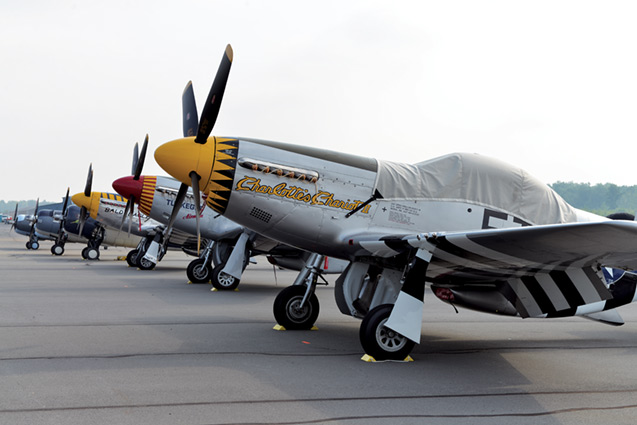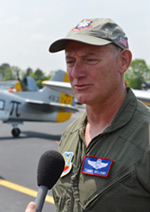Release #: Vol. 84, No. 6
August 01, 2015
Our Stories: Warbirds Over Washington: Arsenal of Democracy Flyover
By Jan W. Steenblik, Technical Editor
On May 8, the 70th anniversary of VE (Victory in Europe) Day, a proud parade of World War II aircraft—the Arsenal of Democracy World War II Victory Capital Flyover—flew over the WWII Memorial in Washington, D.C., to cap ceremonies that honored the men and women who fought in the war and those on the home front who produced what U.S. President Franklin D. Roosevelt called the “arsenal of democracy” to win the war.
In one of the most diverse arrays of WWII aircraft ever assembled, the flyover included 56 WWII aircraft flying in 15 historically sequenced warbird formations. The formations represented the war’s major battles, from Pearl Harbor through the final air assault on Japan, and concluded with a missing-man formation to “Taps.”
The major participants in and sponsors of the flyover included the Commemorative Air Force, the General Aviation Manufacturers Association, the International Council of Air Shows, the National Air Traffic Controllers Association, the Military Aviation Museum, and the Texas Flying Legends Museum.
ALPA members take flight
The day before the flyover, Air Line Pilot caught up with some of the ALPA members who participated in this historic event.
The trainers, fighters, torpedo bombers, and twin-engine warbirds were based at Culpeper Regional Airport in northern Virginia, while the four-engined bombers (B-17s, B-24, and B-29) staged at Manassas Regional Airport nearby.
As the warbirds returned from a practice mission over the Virginia countryside, the drone of four Pratt R-1830s mixed with that of Rolls Royce V-12 Merlins: F/O Paul Stojkov (United) and Capt. Allen Benzing (Delta, Ret.) passed overhead at the controls of a Consolidated B-24 Liberator heavy bomber, escorted by three North American P-51 Mustang fighters. Also drawing gaping fence-hangers’ eyes skyward was Fifi, the last flying Boeing B-29, which Capt. Jeff Linebaugh (FedEx Express) flies when he’s not piloting a B-757 or Gunfighter, a P-51D.
Soon the Mustang pilots returned rubber to pavement with a sweet skritch, skritch, the cracklecracklecrackle Merlins protesting being throttled back (these ponies still want to run!).
Dismounting from an FG-1D Corsair, the famed Navy fighter with its distinctive inverted gullwing silhouette, Capt. John Fuentes (United), a B-767 pilot, reported that the practice flights had gone well. The formation flights, he said, were just the final step in what had been more than a year of planning and preparation, including a dry run in October 2014 for all the government agencies involved in approving the event.
Capt. Tommy Williams (Delta), who also is a brigadier general in the U.S. Air Force Reserves and a former F-16 driver, stood beside a North American P-51D Mustang, Long Island Kid. “This is like a fighter base in World War II,” he said, motioning at the busy ramp. “To be a part of this, to honor our veterans who are passing on at such a high rate, is incredible.
“For me, these airplanes are hallowed ground. When I climb into the cockpit, I’m thinking about the young man who went to war in this airplane. What he did is significantly different from what we’re doing with these airplanes, significantly more challenging. And although we have a great time flying these airplanes, we don’t come close to what those young men went through.”
Capt. Larry Lumpkin (United)—like Williams, an A320 pilot during his day job—stood beside Gunfighter, wearing the German POW dog tags of a former Mustang pilot. The WWII veteran’s daughter asked Lumpkin to take the dog tags, her dad’s military flying hat, and a small flag with him during the flyover.
“I had the privilege of meeting her dad just before he passed away,” Lumpkin recalled. “He was at an air show in St. Joe, Missouri, and he was very ill at the time, and he passed away just after that show. But it was very special for him to come out and sit underneath the wing in his wheelchair and visit with us and just be part of the group. We became very close to the family.”

P-51 Charlottes Chariot II
Nearby, Capt. Brad Lang (Delta), who flies a P-51C in the colors of the famed Tuskegee Airmen, gave an interview to a Japanese television crew. The son of one of the barrier-busting African-American pilots who proved that they could fly and fight as well as their white brothers-in-arms, Lang has dedicated himself to making sure younger generations do not forget this important history and the lessons to be learned from it.
Across the ramp was F/O Alan Miller (Delta), who sometimes flies the Tuskegee Airmen Mustang, but for this event was flying a North American B-25 Billy Mitchell medium bomber, Betty’s Dream, with his dad flying copilot.
Of the B-25, outfitted with nose guns as a low-level attack platform against shipping and harbor installations, Miller observed, “It’s a neat old airplane. This thing snorts and rips and smokes; it’s very loud and vibrates a lot. Getting the motor started is a lot more difficult than starting, for example, the A330 I fly for the airline. But it’s really rewarding.”
Honoring veterans
“We meet a lot of veterans—especially flying the B-25, with the focus on the Doolittle Raiders,” Miller noted. “I’ve been to probably six or seven of the Raiders reunions and met a lot of those great American heroes, so the payoff’s worth all the time I spend doing it.
“This is all about honoring the veterans and telling their stories; there aren’t many of them left. We want the younger people to see these airplanes. It’s living history. The veterans we’re trying to honor are going to be gone pretty soon. So we’re trying to tell their story.”
Flying a TBM torpedo bomber was F/O Josh Wilson (JetBlue), who the next day would peel off from the formation as it passed the WWII Memorial and make an emergency landing at Washington National. Wilson later would post a YouTube video providing the pilot’s-eye (well, GoPro) view of what appeared to be a cockpit fire but turned out to be a pinhole hydraulic system leak.
“During my 10-minute time dilation on final approach,” Wilson posted in his YouTube video, “the magnitude of this day really hit home. I have flown with and met hundreds of WWII vets by flying these old airplanes, and all of them had lost people they knew in combat. I…thought how fortunate I was able to land immediately.
“As a nation, we owe so much to these men who didn’t have an airfield right underneath them when their planes caught fire. They were hundreds of miles away from the nearest friendly landing spot, under enemy fire. Many of them made the ultimate sacrifice for our nation.
“It is an honor and a privilege to be able to display this living history to the next generation so we will never forget those who have gone before us.”
You, Too, Can Fly Warbirds
The groups that “keep ’em flying” need pilots.
Asked if he would recommend this experience to other ALPA members, Capt. Larry Lumpkin (United) declared, “Absolutely! It takes time and patience. You’ve got to put in a lot of sweat equity and have a great attitude. But if you really, really want to make it happen, you can make it happen.”

Another common route begins with checking out as a copilot on a multiengine bomber.
Are you an interested pilot? Read How to Become a CAF Pilot. Keep ’em flying!
Related Story: Flying's In Their Blood
This article is from the August 2015 issue of Air Line Pilot magazine, the Official Journal of the Air Line Pilots Association, International—a monthly publication for all ALPA members.
-###-

